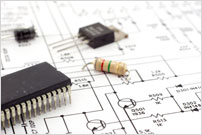The Brief Illustrated History of Everyday Electronics
Here are some pictures of early issues of Everyday Electronics and Practical Electronics which we are sure readers will find fascinating. They depict the magazine style and typify some adverts of the period.
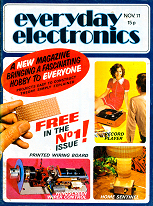 The first ever issue of Everyday Electronics appeared in October 1971 (the Nov. 71 issue). A free piece of stripboard was included. The projects were a dusk-dawn light switch, a "Snap" game, a record player and windscreen wiper controller. "Teach-In" by Mike Hughes started wiith soldering skills. Mike Kenward wrote the Shop Talk column.
The first ever issue of Everyday Electronics appeared in October 1971 (the Nov. 71 issue). A free piece of stripboard was included. The projects were a dusk-dawn light switch, a "Snap" game, a record player and windscreen wiper controller. "Teach-In" by Mike Hughes started wiith soldering skills. Mike Kenward wrote the Shop Talk column.
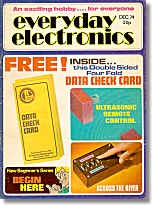 The Dec. 74 (Vol. 3 No. 12) issue shows the original style of EE. It included a MW Reflex Receiver by R A Penfold, "Across the River" game by F.G. Rayer, Shop Talk (by Asst. Editor Mike Kenward), and an article on "The World of the IC" describing these marvels of miniaturisation. This issue included a free Data Check Card. The magazine was produced for beginners in electronics by the same Editorial team responsible for its heavyweight sister publication Practical Electronics
The Dec. 74 (Vol. 3 No. 12) issue shows the original style of EE. It included a MW Reflex Receiver by R A Penfold, "Across the River" game by F.G. Rayer, Shop Talk (by Asst. Editor Mike Kenward), and an article on "The World of the IC" describing these marvels of miniaturisation. This issue included a free Data Check Card. The magazine was produced for beginners in electronics by the same Editorial team responsible for its heavyweight sister publication Practical Electronics
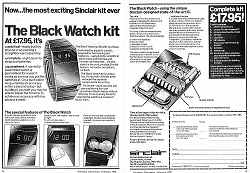
(1976) Sinclair Radionics Ltd. was a major advertiser at the time - above is the "Black Watch" l.e.d. digital watch kit, the purposeful style of which typified Sinclair's approach to its products.
 This April 1983 issue (note the different logo, introduced in Sept. 1977) included an Add-on Amplifier for the Sinclair ZX Spectrum colour computer, an expanded add-on keyboard for the Sinclair ZX81 and a novelty egg timer and a Flanger Sound Effect by R A Penfold. "Circuit Exchange" enabled readers to publish their own circuits.
This April 1983 issue (note the different logo, introduced in Sept. 1977) included an Add-on Amplifier for the Sinclair ZX Spectrum colour computer, an expanded add-on keyboard for the Sinclair ZX81 and a novelty egg timer and a Flanger Sound Effect by R A Penfold. "Circuit Exchange" enabled readers to publish their own circuits.
A reader's letter deplored the use of new-fangled printed circuit boards, and wanted to "keep it on stripboard". "For Your Entertainment" featured every month, written by Barry Fox, who still writes extensively today. The magazine title was to change from the next issue...
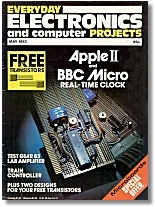 May 1983 saw the title change to Everyday Electronics and Computer Projects, heralding the era of home computing together with the surge in interest in constructing peripheral projects which the magazine embraced head-on.
May 1983 saw the title change to Everyday Electronics and Computer Projects, heralding the era of home computing together with the surge in interest in constructing peripheral projects which the magazine embraced head-on.
This edition included RTC circuits for the Apple II and the BBC Micro, a temperature sensor for the Commodore PET and VIC20 computers, plus a MW Radio and a model train controller.
We also saw the launch of the EE Software Service - programs for computer-based projects were available to buy... but as floppy drives barely existed, they were only available on cassette tapes! The June 83 issue was to carry an EPROM Programmer for the Tandy TRS-80.
 Onwards to the October 1984 issue, edited by a young Mike Kenward. A drill speed controller, quiz scoreboard and mains cable detector were detailed, along with the Micro Memory Synthesiser based on a dedicated chip. The Everyday News column proclaimed the "world's first pocket computer" - hailing the new Psion Organiser, by mail order only from Psion Processors. It weighed half a pound, was supplied with an 8K data pack, and cost £100.
Onwards to the October 1984 issue, edited by a young Mike Kenward. A drill speed controller, quiz scoreboard and mains cable detector were detailed, along with the Micro Memory Synthesiser based on a dedicated chip. The Everyday News column proclaimed the "world's first pocket computer" - hailing the new Psion Organiser, by mail order only from Psion Processors. It weighed half a pound, was supplied with an 8K data pack, and cost £100.
The Sinclair QL computer was launched - the "Quantum Leap" for the serious home or professional user. An EE reviewer noted prophetically that "so many computers are arriving all the time, making it inevitable that some will never make it. Maybe the QL will, who knows?" Sadly, it didn't.
 This 1974 advert for the Sinclair Cambridge calculator - "Britain's most popular pocket calculator" at £14.95 in kit form (£32.95 built), illustrates one of many innovative products created by Clive Sinclair who advertised heavily in EE and PE. The Cambridge had an l.e.d. display and the batteries lasted "for weeks". A Scientific version existed too. Not every Sinclair kit was quite a success in practice. Other advertisers included Home Radio (Components) Ltd. of Mitcham, Surrey with their famous catalogue, also J. Bull (Electrical) Ltd. who still advertise today, and Henry's Radio of London, then the biggest catalogue retailer in England, and ElectroValue Ltd.of Egham, Surrey who finally closed their doors in 2005. A letter from David Longland, the owner of ElectroValue, was published in the June 2006 issue.
This 1974 advert for the Sinclair Cambridge calculator - "Britain's most popular pocket calculator" at £14.95 in kit form (£32.95 built), illustrates one of many innovative products created by Clive Sinclair who advertised heavily in EE and PE. The Cambridge had an l.e.d. display and the batteries lasted "for weeks". A Scientific version existed too. Not every Sinclair kit was quite a success in practice. Other advertisers included Home Radio (Components) Ltd. of Mitcham, Surrey with their famous catalogue, also J. Bull (Electrical) Ltd. who still advertise today, and Henry's Radio of London, then the biggest catalogue retailer in England, and ElectroValue Ltd.of Egham, Surrey who finally closed their doors in 2005. A letter from David Longland, the owner of ElectroValue, was published in the June 2006 issue.
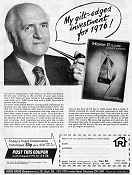 February 1976. Home Radio Components Ltd. were a popular mail order supplier, characterised by some quaint advertising and a high quality catalogue.
February 1976. Home Radio Components Ltd. were a popular mail order supplier, characterised by some quaint advertising and a high quality catalogue.
Its cover had a colour photo of the sculpture "Theme on Electronics" by Barbara Hepworth, commissioned by Mullard in 1957.
The owner of Home Radio wrote a small monthly column called "Counter Intelligence" for the magazine.

This advert was typical of those from Sinclair in the 1980s. The Sinclair ZX80 and ZX81 were defining points in the development of the home computer, selling over 500,000 units in kits and ready built. The Sinclair ZX Spectrum in this advert brought colour (no less than 8 to choose from!) and sound to home computing enthusiasts.
With a choice of 16K or 48K RAM, and an add-on mini printer, plus the ill-starred MicroDrive tape back-up (capacity 100K) it was the origin of many a readers' gentle initiation into the exciting new world of affordable home computing, and was to help have a profound impact on the future direction of the magazine. Price for the Spectrum was £125.00 (with a glorious 16K RAM).
 February 1984 EE - featuring a Sinclair ZX81 EPROM Programmer and a home-brew Ioniser, a signal tracer by R. A. Penfold, a car lights warning, an Oric Computer port board and a stereo speaker protection unit. A relay driver for the ZX computer was described. The EE printed circuit board service listed boards from June 1983 onwards.
February 1984 EE - featuring a Sinclair ZX81 EPROM Programmer and a home-brew Ioniser, a signal tracer by R. A. Penfold, a car lights warning, an Oric Computer port board and a stereo speaker protection unit. A relay driver for the ZX computer was described. The EE printed circuit board service listed boards from June 1983 onwards.
Teach-In 84 by George Hylton dealt with audio amplifiers. The Editorial by Fred Bennett described the advent of "SMA" - surface mount assembly - adding the comforting note for constructors that "lead bending and cropping will remain essential operations for the home constructor, for far enough into the future as makes no difference."
The Everyday News column reported on the advent of digital TV. The world's first multifunctional digital TV set was announced by Panasonic in Japan. It had 30% fewer components than analogue sets, and it was viewdata/ hi-fi and home computer compatible. Digital TV was hailed in 1984 as "marking a new generation that will serve as the focal point for the home information centre of the future."
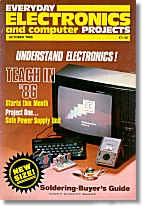 The October 1985 issue changed to a larger size format, still with us today. It included a simple reverb unit by a certain John M.H. Becker, a soldering iron power controller, a strain gauge amplifier, but strangely no computer projects this month!
The October 1985 issue changed to a larger size format, still with us today. It included a simple reverb unit by a certain John M.H. Becker, a soldering iron power controller, a strain gauge amplifier, but strangely no computer projects this month!
A Soldering Instrument Buyer's Guide was included free, including names such as Adcola and Antex. Teach-In 86 by Mike Tooley & David Whitfield started with basic battery and resistor experiments. Uniquely, the tutorial electronics series was accompanied by some computer software, for the Sinclair Spectrum or the BBC Micro.
Meantime, Everyday News reported on the launch of the revolutionary new Amstrad PCW8256 Personal Computer Word Processor, with "high resolution" green monitor, 3" disk drive and dot matrix printer, all yours for £450.

